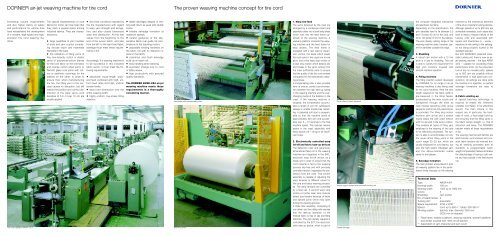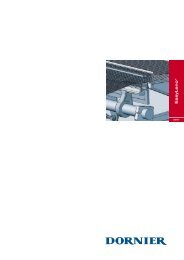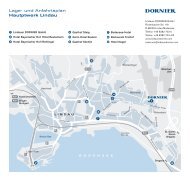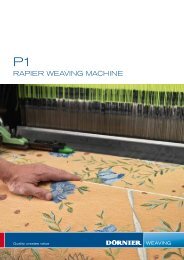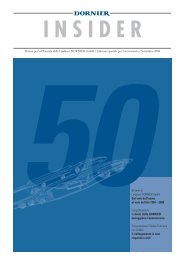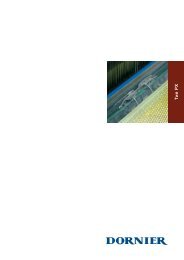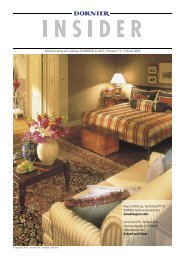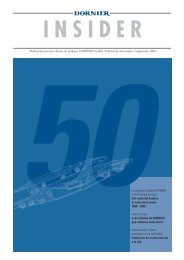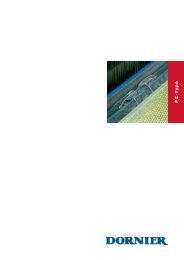DORNIER air-jet weaving machine for tire cord - Lindauer DORNIER ...
DORNIER air-jet weaving machine for tire cord - Lindauer DORNIER ...
DORNIER air-jet weaving machine for tire cord - Lindauer DORNIER ...
You also want an ePaper? Increase the reach of your titles
YUMPU automatically turns print PDFs into web optimized ePapers that Google loves.
<strong>DORNIER</strong> <strong>air</strong>-<strong>jet</strong> <strong>weaving</strong> <strong>machine</strong> <strong>for</strong> <strong>tire</strong> <strong>cord</strong><br />
Increasing volume requirements<br />
and also higher claims on safety<br />
and per<strong>for</strong>mance <strong>for</strong> vehicle <strong>tire</strong>s<br />
have necessitated the development<br />
of a modern, high-speed and highprecision<br />
<strong>tire</strong> <strong>cord</strong> <strong>weaving</strong> <strong>machine</strong>.<br />
Tire <strong>cord</strong> installation AWSR 4/E4<br />
The special characteristics of <strong>cord</strong><br />
fabrics <strong>for</strong> motor car <strong>tire</strong>s mean that<br />
they claim a special status among<br />
industrial fabrics. They are characterized<br />
by:<br />
• large quantities of yarn (number<br />
of ends and yarn counts) comprising<br />
viscose rayon and manmade<br />
filaments in the warp<br />
• the utilization of filling yarns of<br />
fine, low-tenacity cotton or elastic<br />
yarns of polyamide/cotton blends<br />
<strong>for</strong> the <strong>cord</strong> fabric on the one hand,<br />
and coarse cotton plied yarns or<br />
filament glass core yarns with cotton<br />
or synthetic coverings <strong>for</strong> the<br />
tabbies on the other. In order to<br />
ensure that, when manufacturing<br />
the <strong>tire</strong>, the filling yarn in the carcass<br />
causes no disruption, but still<br />
retains the position and correct distribution<br />
of the warp yarns, pick<br />
densities of 5.0–14 per 10 cm are<br />
usually applied<br />
• strict test conditions imposed by<br />
the <strong>tire</strong> manufacturers with regard<br />
to warp yarn strength and elongation,<br />
and also closely toleranced<br />
warp end distribution. All the test<br />
values from the beginning to the<br />
end of the woven batch, and also<br />
from the left- to the right-hand fabric<br />
selvedge must meet these requirements<br />
in full.<br />
Ac<strong>cord</strong>ingly, if a <strong>weaving</strong> <strong>machine</strong> is<br />
to be successful in this industrial<br />
fabric sector, it must meet the following<br />
requirements:<br />
• absolutely equal-length warpend<br />
feed combined with high, uni<strong>for</strong>m<br />
feed rates and high, uni<strong>for</strong>m<br />
tension levels,<br />
• exact end distribution over the<br />
en<strong>tire</strong> <strong>weaving</strong> width,<br />
• highly uni<strong>for</strong>m, low-stress filling<br />
insertion,<br />
• stable selvedges despite of missing<br />
weft return as usual with shuttle<br />
looms,<br />
• reliable selvedge <strong>for</strong>mation at<br />
maximum speeds,<br />
• careful guidance of the slipsensitive<br />
fabric over guide roll combinations<br />
to the batching motion,<br />
• adjustable winding hardness on<br />
the fabric roll with no distortion or<br />
skew in the batch,<br />
• cylindrical and flush selvedge<br />
build-up on batch roll,<br />
• easy handling when <strong>weaving</strong>,<br />
• automatic change-over to <strong>cord</strong><br />
or tabby weave,<br />
• high productivity with assured<br />
quality standards.<br />
The <strong>DORNIER</strong> AWSR 4/E4 <strong>air</strong>-<strong>jet</strong><br />
<strong>weaving</strong> <strong>machine</strong> meets these<br />
requirements in a thoroughly<br />
convincing manner.<br />
The proven <strong>weaving</strong> <strong>machine</strong> concept <strong>for</strong> <strong>tire</strong> <strong>cord</strong><br />
1. Warp end feed<br />
The yarns delivered by the creel are<br />
arranged by a condenser board and<br />
assembly rollers into a level warp sheet<br />
which runs into the feed frame upstream<br />
of the <strong>weaving</strong> <strong>machine</strong>. A<br />
weaver’s plat<strong>for</strong>m connects the <strong>weaving</strong><br />
<strong>machine</strong> and the feed frame <strong>for</strong><br />
easy access. The feed frame is<br />
equipped with a rear reed or expansion<br />
combs, the lease which keeps<br />
the <strong>cord</strong> yarns in the usual one-to-one<br />
pitch, and a first warp stop motion or<br />
a laser stop motion which detects any<br />
end breaks in the yarns arising from<br />
the creel sufficiently early to ensure<br />
that the quality of the <strong>tire</strong> <strong>cord</strong> remains<br />
unimp<strong>air</strong>ed <strong>for</strong> the downstream <strong>weaving</strong><br />
process.<br />
A compensating roller is also provided<br />
here to ensure, perfect synchronisation<br />
between the high take-up speed<br />
in the <strong>weaving</strong> <strong>machine</strong> and the everchanging<br />
inertia of the bobbins in the<br />
creel. If the <strong>weaving</strong> <strong>machine</strong> is<br />
Feed frame with compensating roller<br />
stopped, the compensator accumulates<br />
a length of yarn <strong>for</strong> subsequent<br />
release to enable trouble-free restarting.<br />
A patented soft start is programable<br />
so that the <strong>machine</strong> starts at<br />
approximately 320 rpm and accelerates<br />
over 5 – 10 seconds to the final<br />
<strong>machine</strong> speed. This reduces tension<br />
peaks in the creel, especially with<br />
heavy spools (10 – 12 kg) or an insufficient<br />
creel.<br />
Trio of rollers <strong>for</strong> fabric transport<br />
Batching device<br />
2. Electronically controlled warp<br />
let-off and fabric take-up devices<br />
The deflection roller and generously<br />
dimensioned feed roll in the <strong>weaving</strong><br />
<strong>machine</strong> are integrated in the EWL,<br />
electronic warp let-off device, as a<br />
single unit in order to ensure that the<br />
<strong>cord</strong> material is fed to the <strong>weaving</strong><br />
process slip-free and with precisely<br />
controlled tension, regardless the pretension<br />
from the creel. This control<br />
assembly is capable of adjusting the<br />
warp tensions to different values <strong>for</strong><br />
the <strong>cord</strong> and tabby <strong>weaving</strong> processes.<br />
The warp tensions are controlled<br />
by a load cell. A second warp stop<br />
motion or further laser stop motions<br />
detect <strong>cord</strong> breaks because of knots<br />
and spliced joints which may open<br />
during the <strong>weaving</strong> process.<br />
A triple roller assembly, comprising of<br />
one driven and two idling rolls ensures<br />
that the take-up operation of the<br />
finished fabric is free of slip and filling<br />
distortion. The pick density required is<br />
controlled by the ECT, the electronic<br />
cloth take up device, which is part of<br />
Temple support system and pneumatic tucking unit<br />
Tucked selvedge<br />
the computer integrated mechanical<br />
and electronic functions.<br />
Depending on the specification, the<br />
pick densities tend to lie between 5.0<br />
and 14 picks/10 cm <strong>for</strong> the <strong>cord</strong>, and<br />
40 to 100 picks/10 cm <strong>for</strong> the tabbies.<br />
The pick density setting range of the<br />
<strong>weaving</strong> <strong>machine</strong> does, however, permit<br />
<strong>for</strong> densities outside this range.<br />
3. Shedding<br />
A robust cam motion with a 12 mm<br />
pitch is in use <strong>for</strong> shedding. This unit<br />
is able to satisfy the requirement <strong>for</strong><br />
high yarn tensions coupled with<br />
smooth <strong>machine</strong> operation.<br />
4. Filling insertion<br />
The filling insertion system developed<br />
by <strong>DORNIER</strong> <strong>for</strong> its range of <strong>air</strong>-<strong>jet</strong><br />
<strong>weaving</strong> <strong>machine</strong>s is also being used<br />
<strong>for</strong> <strong>tire</strong> <strong>cord</strong> <strong>machine</strong>s. Here the yarn<br />
length required <strong>for</strong> the fabric width is<br />
pre-measured in the filling feeder,<br />
accelerated by the main nozzle and<br />
transported through the shed by<br />
relay nozzles operating under group<br />
sequence control are fully electronically<br />
controlled. The filling stop motion<br />
monitors yarn arrival and a stretch<br />
nozzle keeps the weft under tension<br />
until it is secured in the tuck-in motion.<br />
This enables all types of filling yarn<br />
employed in the <strong>weaving</strong> of <strong>tire</strong> <strong>cord</strong><br />
to be effectively processed. The system<br />
is able to accommodate not only<br />
the usual cotton filling yarns in the<br />
count range 20–33 tex, which are<br />
usually employed <strong>for</strong> <strong>cord</strong> fabrics, but<br />
also the high elastic Olboplast yarn<br />
and the above-mentioned coarse<br />
yarns <strong>for</strong> the tabbies.<br />
5. Selvedge <strong>for</strong>mation<br />
The main problem encountered in prior<br />
art <strong>weaving</strong> systems lies in the per<strong>for</strong>mance<br />
limits imposed on the <strong>weaving</strong><br />
Technical Data:<br />
<strong>machine</strong> by the mechanical elements<br />
of the all-so-important tucking devices.<br />
Although speeds of up to 600 rpm are<br />
achievable nowadays, such values also<br />
tend to lead to frequent failure of the<br />
tucking units and associated with<br />
rep<strong>air</strong>s and downtimes or – worse –<br />
rejections of rolls owing to the selvedges<br />
not being properly tucked to the<br />
standard required.<br />
But with <strong>DORNIER</strong>’s patented pneumatic<br />
tucking unit, there is now an <strong>air</strong><strong>jet</strong><br />
<strong>weaving</strong> <strong>machine</strong> – the type AWSR<br />
4/E4 – capable <strong>for</strong> exceeding these<br />
per<strong>for</strong>mance limits. As the pneumatic<br />
tuck-in has no movable parts, speeds<br />
up to 800 rpm are possible without<br />
maintenance or high spare part consumption.<br />
All settings are done while<br />
the <strong>machine</strong> is in operation, so perfect<br />
selvedge <strong>for</strong>mations are easy to<br />
achieve.<br />
6. Fabric winding-up<br />
A special batching technology is<br />
required to enable the inherently<br />
unstable <strong>cord</strong> fabric to be effectively<br />
wound. The main criteria in this<br />
respect are, in particular, the hardness<br />
of wind, a flush-edge build-up<br />
and ensuring that the filling yarns in<br />
the fabric remain straight, i.e. free of<br />
distortion and skew. The <strong>DORNIER</strong><br />
batcher meets all these requirements<br />
in full.<br />
The <strong>weaving</strong> <strong>machine</strong> and batcher are<br />
electronically synchronised and constant<br />
fabric tensions are ensured during<br />
all <strong>weaving</strong> processes even at<br />
standstill. A programmable batch<br />
weight compensation feature eliminates<br />
the disadvantage of having a soft centre<br />
and hard outside in the final-wound<br />
roll.<br />
Type: AWSR 4/E4<br />
Nominal width: 190 cm<br />
Working width: 1000 up to 1880 mm<br />
Colors: 4<br />
Shedding: cam motion<br />
No. of heald frames: 4<br />
Tucking unit: pneumatic<br />
Space requirement: 4790 x 5790 * )<br />
Speed: <strong>cord</strong>: up to 800 n –1 ; tabby: 300-350 n –1<br />
Winding system: batcher, max. diameter 1800 mm<br />
(2000 mm on request)<br />
* ) Feed frame, weaver’s plat<strong>for</strong>m, <strong>weaving</strong> <strong>machine</strong>, weaver’s plat<strong>for</strong>m<br />
and winder covered with 1800 mm Ø batcher<br />
** ) dependent on yarn character and yarn count
Extensive automation <strong>for</strong> easy handling<br />
7. Automatic tabby <strong>weaving</strong><br />
A further important advantage available<br />
with this new <strong>machine</strong> lies in its<br />
automatic tabby <strong>weaving</strong> facility. All<br />
the production-specific data of a<br />
batch, relating to the lengths and<br />
changes between <strong>cord</strong>- and tabby<strong>weaving</strong>,<br />
are transferred together<br />
with the relevant settings by floppy<br />
disc or online to the computer of<br />
the <strong>weaving</strong> <strong>machine</strong>, and then<br />
automatically implemented. For the<br />
tabby <strong>weaving</strong> process, the <strong>machine</strong><br />
automatically changes the filling<br />
yarn without stopping, increasing<br />
the pick density and warp<br />
tension to the pre-set values. The<br />
speed is reduced to the programed<br />
level. At the pre-programed point,<br />
the temple swings in to the start of<br />
the tabby fabric. At the end of the<br />
tabby, the same functions are per<strong>for</strong>med<br />
again, but in reverse order.<br />
The <strong>DORNIER</strong> programing system<br />
offers free selectability in respect of<br />
pick density, yarn tension, speed,<br />
fabric length and batch build to<br />
accommodate all the <strong>cord</strong> fabrics<br />
encountered in the market place.<br />
After the <strong>weaving</strong> and <strong>machine</strong> control<br />
data have been entered, they<br />
are stored ready <strong>for</strong> reloading <strong>for</strong><br />
repeat batches at a later date.<br />
This <strong>air</strong>-<strong>jet</strong> <strong>weaving</strong> <strong>machine</strong><br />
in combination with the pneumatic<br />
tucking units offers a<br />
very simple handling, minimum<br />
maintenance with a maximum<br />
output and productivity,<br />
with a minimum space<br />
requirement, with a corresponding<br />
reduction in the requisite<br />
capital outlay. Experts<br />
will be quick to recognize that<br />
these advantages also mean<br />
faster material throughput and<br />
reduced capital tie-up in<br />
inventories.<br />
With full automation of the<br />
<strong>cord</strong> conversion process, we<br />
are able to offer to the <strong>tire</strong><br />
<strong>cord</strong> industry a technological<br />
lead based on superior per<strong>for</strong>mance<br />
characteristics coupled<br />
with assured attainment of the<br />
required quality standards.<br />
Pneumatically controlled swivel temple support in tabby position<br />
Electric-electronic control<br />
<strong>Lindauer</strong> <strong>DORNIER</strong> GmbH<br />
88129 Lindau/Germany<br />
Telephone +49 8382 7030<br />
Telefax +49 8382 703386<br />
American <strong>DORNIER</strong> Machinery Corp.<br />
P.O. Box 668865<br />
Charlotte, N.C. 28266, USA<br />
Telephone +1 704 394 6192<br />
Telefax +1 704 399 2018<br />
<strong>DORNIER</strong> Machinery (Shanghai) Co. Ltd.<br />
Area B G/F Block 45<br />
299 Fu TeZhong Road<br />
WaiGaoQiao Tax Free Zone<br />
Shanghai 200131, P.R. China<br />
Telephone +81 21 5046 2838<br />
Telefax +81 21 5046 2138<br />
<strong>DORNIER</strong> Machinery India<br />
Private Limited<br />
201-A, Sangeet Plaza<br />
Marol Maroshi Road<br />
Andheri (East)<br />
Mumbai 400 059, India<br />
Telephone +91 22 859 8758<br />
Telefax +91 22 859 8760<br />
http://www.lindauerdornier.com<br />
webmaster@lindauerdornier.com<br />
4005/LD/11/07 Sub<strong>jet</strong> to change without notice<br />
TireCord


